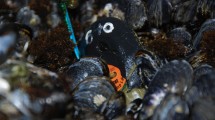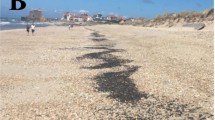Abstract
The rocky intertidal mussel Mytilus californianus is exposed to potentially damaging thermal conditions during low tide. However, because the temperatures of ectothermic organisms are driven by multiple climatic factors, we do not fully understand what the body temperatures of intertidal invertebrates are under field conditions, or how thermal stress varies between intertidal sites. We designed a temperature logger that thermally matches (similar size, color, morphology and thermal inertia) living mussels of the species M. californianus, and tested its ability to provide realistic measurements of body temperature in the field. As part of these tests, we examined the propensity of M. californianus to “gape,” a behavior in which the mussel opens its shell valves, and which may permit evaporative cooling. Because our instruments were unable to mimic this behavior, we tested the degree to which gaping contributes to animal cooling by exposing M. californianus to a range of climatic conditions while recording body temperatures, gaping behavior and water loss. Results indicated no significant influence of gaping on body temperature. Tests comparing temperatures of loggers to those of real mussels under laboratory and field conditions showed that thermally matched loggers recorded temperatures within a few degrees of living animals and that unmodified loggers regularly incurred errors of up to 14°C. We then deployed a series of thermally matched loggers at two sites in central Oregon (Boiler Bay and Strawberry Hill) previously hypothesized to display site-specific differences in aerial temperature, and at various wave-exposure regimes within each site. Significant differences were demonstrated between sites using a subset of temperature metrics in a multivariate analysis. Yearly peaks in maximum temperature, average daily maximum temperature, and degree hours were useful in discriminating between sites. In 2001, wave-exposed sites at Strawberry Hill displayed fewer degree–hours than wave-protected sites, but an equivalent or greater maximum temperature. In 2002 both of these metrics were significantly lower in wave-exposed sites. Boiler Bay and Strawberry Hill differed in thermal regime, but not in a way that would indicate one was “hotter” than the other.




Similar content being viewed by others
References
Ameyaw-Akumfi C, Naylor E (1987) Temporal patterns of shell-gape in Mytilus edulis. Mar Biol 95:237–242
Barry JP, Baxter CH, Sagarin RD, Gilman SE (1995) Climate-related, long-term faunal changes in a California rocky intertidal community. Science 267:672–675
Bayne BL, Bayne CJ, Carefoot TC, Thompson RJ (1976a) The physiological ecology of Mytilus californianus Conrad. Oecologia 22:211–228
Bayne BL, Bayne CJ, Carefoot TC, Thompson RJ (1976b) The physiological ecology of Mytilus californianus Conrad 2. Adaptation to low oxygen tension and air exposure. Oecologia 22:229–250
Bell EC (1995) Environmental and morphological influences on thallus temperature and desiccation of the intertidal alga Mastocarpus papillatus Kützing. J Exp Mar Biol Ecol 191:29–55
Brawley SH, Johnson LE (1991) Survival of fucoid embryos in the intertidal zone depends upon developmental stage and microhabitat. J Phycol 27:179–186
Buatois A, Croze JP (1978) Thermal responses of an insect subjected to temperature variations. J Therm Biol 3:51–56
Buckley BA, Owen M-E, Hofmann GE (2001) Adjusting the thermostat: the threshold induction temperature for the heat-shock response in intertidal mussels (genus Mytilus) changes as a function of thermal history. J Exp Biol 204:3571–3579
Dahlhoff EP, Menge BA (1996) Influence of phytoplankton concentration and wave exposure on the ecophysiology of Mytilus californianus. Mar Ecol Prog Ser 144:97–107
Dahlhoff EP, Buckley BA, Menge BA (2001) Feeding and physiology of the rocky intertidal predator Nucella ostrina along an environmental gradient. Ecology 82:2816–2829
Dahlhoff EP, Stillman JH, Menge BA (2002) Physiological community ecology: variation in metabolic activity of ecologically important rocky intertidal invertebrates along environmental gradients. Integr Comp Biol 42:862–871
Denny MW, Daniel TL, Koehl MAR (1985) Mechanical limits to size in wave-swept organisms. Ecol Monogr 55:69–102
Elvin DW, Gonor JJ (1979) The thermal regime of an intertidal Mytilus californianus Conrad population on the central Oregon coast. J Exp Mar Biol Ecol 39:265–279
Fields PA, Graham JB, Rosenblatt RH, Somero GN (1993) Effects of expected global climate change on marine faunas. Trends Ecol Evol 8:361–367
Guderley H, Demers A, Couture P (1994) Acclimatization of blue mussel, (Mytilus edulis Linnaeus, 1758) to intertidal conditions: effects on mortality and gaping during air exposure. J Shellfish Res 13:379–385
Halpin PM, Sorte CJ, Hofmann GE, Menge BA (2002) Patterns of variation in levels of Hsp70 in natural rocky shore populations from microscales to mesoscales. Int Comp Biol 42:815–824
Harley CDG, Helmuth BST (2003) Local and regional scale effects of wave exposure, thermal stress, and absolute vs. effective shore level on patterns of intertidal zonation. Limnol Oceanogr 48:1498–1508
Helmuth B (2002) How do we measure the environment? Linking intertidal thermal physiology and ecology through biophysics. Int Comp Biol 42:837–845
Helmuth B, Denny MW (2003) Predicting wave exposure in the rocky intertidal zone: do bigger waves always lead to larger forces? Limnol Oceanogr 48:1338–1345
Helmuth BS, Harley CDG, Halpin P, O’Donnell M, Hofmann GE, Blanchette C (2002) Climate change and latitudinal patterns of intertidal thermal stress. Science 298:1015–1017
Helmuth BST (1998) Intertidal mussel microclimates: predicting the body temperature of a sessile invertebrate. Ecol Monogr 68:51–74
Helmuth BST (1999) Thermal biology of rocky intertidal mussels: quantifying body temperatures using climatological data. Ecology 80:15–34
Helmuth BST, Hofmann GE (2001) Microhabitats, thermal heterogeneity, and patterns of physiological stress in the rocky intertidal zone. Biol Bull 201:374–384
Hofmann GE, Somero GN (1995) Evidence for protein damage at environmental temperature: seasonal changes in levels of ubiquitin conjugates and hsp70 in the intertidal mussel Mytilus trossulus. J Exp Biol 198:1509–1518
Johnson SE (1975) Microclimate and energy flow in the marine rocky intertidal. In: Gates DM, Schmerl RB (eds) Perspectives of biophysical ecology. Springer, Berlin Heidelberg New York, pp 559–587
Kingsolver JG (1983) Ecological significance of flight activity in Colias butterflies: implications for reproductive strategy and population structure. Ecology 64:546–551
Kingsolver JG (1985) Thermal ecology of Pieris butterflies (Lepidoptera: Pieridae): a new mechanism of behavioral thermoregulation. Oecologia 66:540–545
Kingsolver JG (1989) Weather and the population dynamics of insects: integrating physiological and population ecology. Physiol Zool 62:314–334
Leigh EGJ, Paine RT, Quinn JF, Suchanek TH (1987) Wave energy and intertidal productivity. Proc Natl Acad Sci USA 84:1314–1318
Lent CM (1968) Air-gaping by the ribbed mussel, Modiolus demissus (Dillwyn): effects and adaptive significance. Biol Bull 134:60–73
Menge BA (2000) Recruitment vs. postrecruitment processes as determinants of barnacle population abundance. Ecol Monogr 70:265–288
Menge BA, Daley BA, Wheeler PA, Dahlhoff E, Sanford E, Strub PT (1997a) Benthic-pelagic links and rocky intertidal communities: bottom-up effects on top-down control? Proc Natl Acad Sci USA 94:14530–14535
Menge BA, Daley BA, Wheeler PA, Strub PT (1997b) Rocky intertidal oceanography: an association between community structure and nearshore phytoplankton concentration. Limnol Oceanogr 42:57–66
Menge BA, Olson AM, Dahlhoff EP (2002) Environmental stress, bottom-up effects, and community dynamics: integrating molecular-physiological with ecological approaches. Int Comp Biol 42:892–908
Moon TW, Pritchard AW (1970) Metabolic adaptations in vertically separated populations of Mytilus californianus Conrad. J Exp Mar Biol Ecol 5:35–46
Paine RT (1974) Intertidal community structure: experimental studies on the relationship between a dominant competitor and its principal predator. Oecologia 15:93–120
Porter WP, Gates DM (1969) Thermodynamic equilibria of animals with environment. Ecol Monogr 39:245–270
Porter WP, Mitchell JW, Beckman WA, DeWitt CB (1973) Behavioral implications of mechanistic ecology: thermal and behavioral modeling of desert ectotherms and their microenvironment. Oecologia 13:1–54
Roberts DA, Hofmann GE, Somero GN (1997) Heat-shock protein expression in Mytilus californianus: acclimatization (seasonal and tidal-height comparisons) and acclimation effects. Biol Bull 192:309–320
Seed R (1992) Systematics, evolution, and distribution of mussels belonging to the genus Mytilus: an overview. Am Malacol Bull 9:123–137
Seed R, Suchanek TH (1992) Population and community ecology of Mytilus. In: Gosling EM (ed) The mussel Mytilus: ecology, physiology, genetics and culture. Elsevier, Amsterdam, pp 87–169
Shick JM, Gnaiger E, Widdows J, Bayne BL, De Zwaan A (1986) Activity and metabolism in the mussel Mytilus edulis L. during intertidal hypoxia and aerobic recovery. Physiol Zool 59:627–642
Somero GN (2002) Thermal physiology and vertical zonation of intertidal animals: optima, limits, and costs of living. Int Comp Biol 42:780–789
Southward AJ (1958) Note on the temperature tolerances of some intertidal animals in relation to environmental temperatures and geographical distribution. J Mar Biol Assoc UK 37:49–66
Southward AJ, Hawkins SJ, Burrows MT (1995) Seventy years’ observations of changes in distribution and abundance of zooplankton and intertidal organisms in the Western English Channel in relation to rising sea temperature. J Therm Biol 20:127–155
Spotila J R, Lommen PW, Bakken GS, Gates DW (1973) A mathematical model for body temperatures of large reptiles: implications for dinosaur ecology. Am Nat 107:391–404
Stillman JH, Somero GN (1996) Adaptation to temperature stress and aerial exposure in congeneric species in intertidal porcelain crabs (genus Petrolisthes): correlation of physiology, biochemistry and morphology with vertical distribution. J Exp Biol 199:1845–1855
Suchanek TH (1992) Extreme biodiversity in the marine environment: mussel bed communities of Mytilus californianus. Northwest Environ J 8:150–152
Tomanek L (2002) The heat-shock response: its variation, regulation and ecological importance in intertidal gastropods (genus Tegula). Int Comp Biol 42:797–807
Underwood AJ, Chapman MG (1996) Scales of spatial patterns of distribution of intertidal invertebrates. Oecologia 107:212–224
Underwood AJ, Chapman M (1998) A method for analysing spatial scales of variation in composition of assemblages. Oecologia 117:570–578
Venegas RM, Navarette SA, Finke GR (2002) A simple and inexpensive device to measure immersion times in wave exposed shores. J Mar Biol Assoc UK 82:1023–1026
Vermeij GJ (1971) Temperature relationships of some tropical Pacific intertidal gastropods. Mar Biol 10:308–314
Watt WB (1991) Biochemistry, physiological ecology, and population genetics—the mechanistic tools of evolutionary biology. Funct Ecol 5:145–154
Wethey DS (2002) Microclimate and biogeography: the barnacle Chthamalus fragilis in New England. Int Comp Biol 42:872–880
Wolcott TG (1973) Physiological ecology and intertidal zonation in limpets (Acmaea): a critical look at “limiting factors.” Biol Bull 145:389–422
Wu B, Gebremedhin KG (2001) Numerical simulation of flow field around a cow using 3-D body-fitted coordinate system. J Therm Biol 26:563–573
Acknowledgements
Funding for this project was provided by grants from Sigma Xi and the Howard Hughes Medical Institute to T.F., by NSF grant IBN 9985878 to B.H., and by a grant from the National Geographic Society Committee for Research and Exploration to B.H. and G. Hofmann. We gratefully acknowledge the assistance of the Partnership for Interdisciplinary Studies of Coastal Oceans (PISCO), and of the members of Dr. Bruce Menge’s laboratory at Oregon State University, for logistical support and advice. We also thank Dr. P. Sammarco and two anonymous reviewers for their insightful editorial input to this manuscript. Animals were collected in accordance with a permit issued by the Oregon State Department of Fish and Game No. OR2002–455 to P.M.H.
Author information
Authors and Affiliations
Corresponding author
Additional information
Communicated by P.W. Sammarco, Chauvin
Rights and permissions
About this article
Cite this article
Fitzhenry, T., Halpin, P.M. & Helmuth, B. Testing the effects of wave exposure, site, and behavior on intertidal mussel body temperatures: applications and limits of temperature logger design. Marine Biology 145, 339–349 (2004). https://doi.org/10.1007/s00227-004-1318-6
Received:
Accepted:
Published:
Issue Date:
DOI: https://doi.org/10.1007/s00227-004-1318-6




